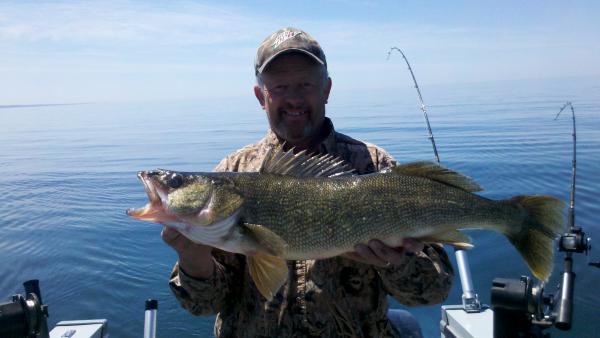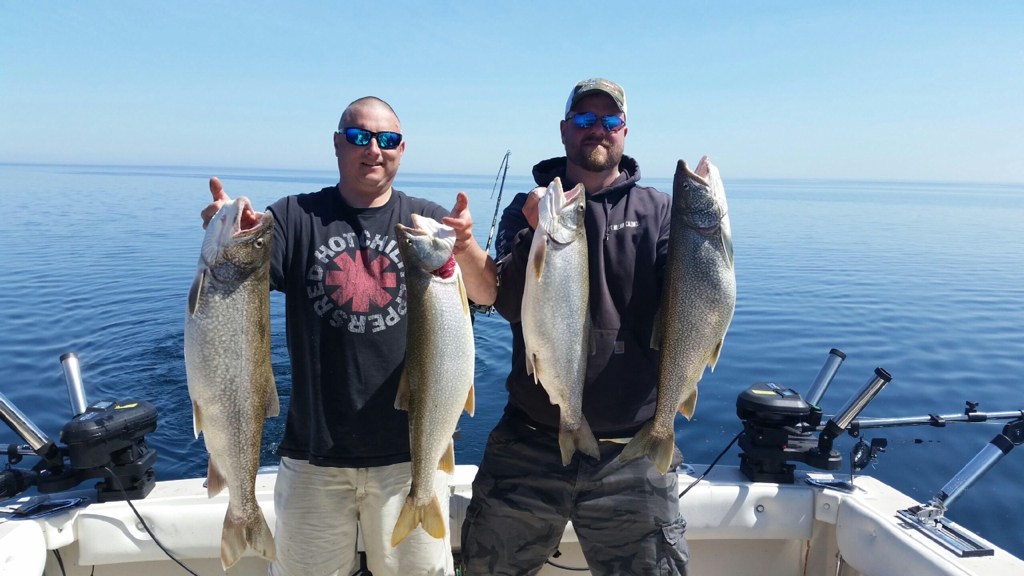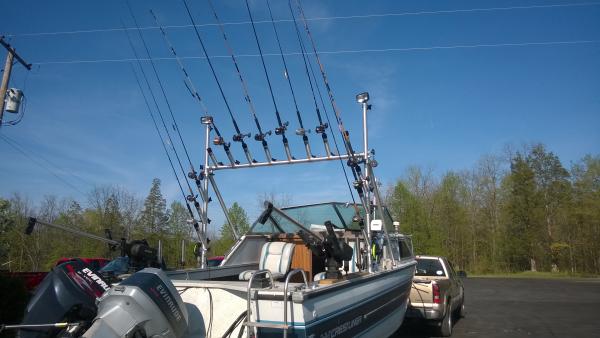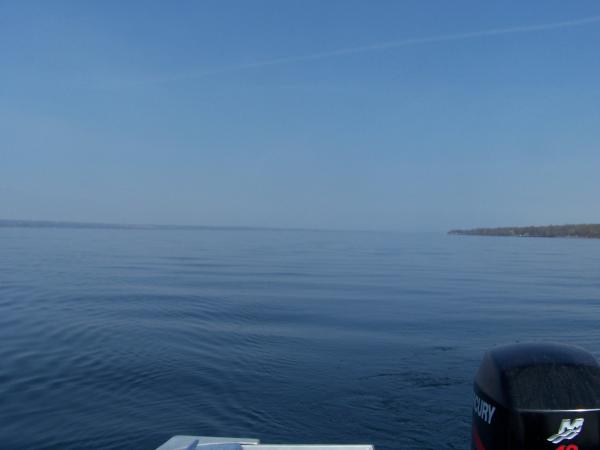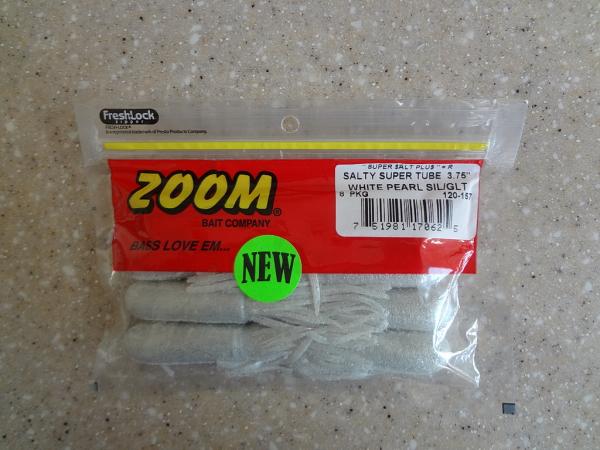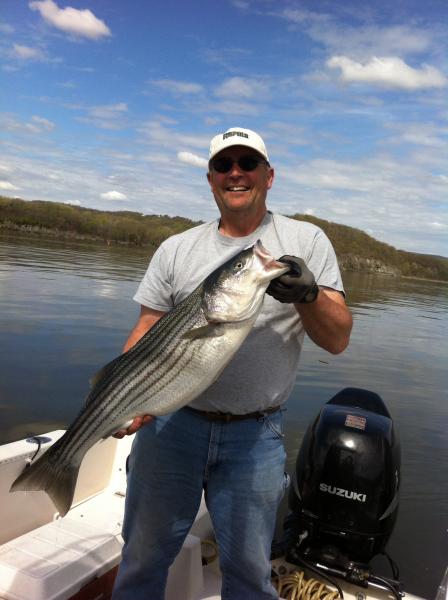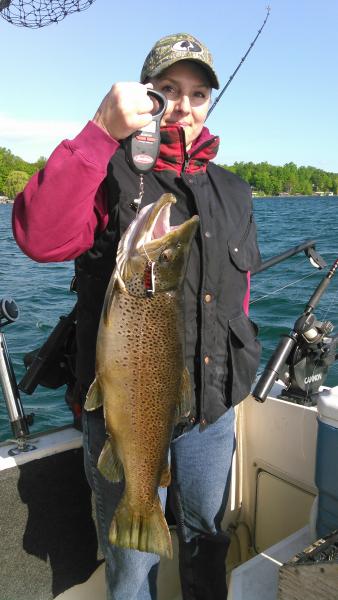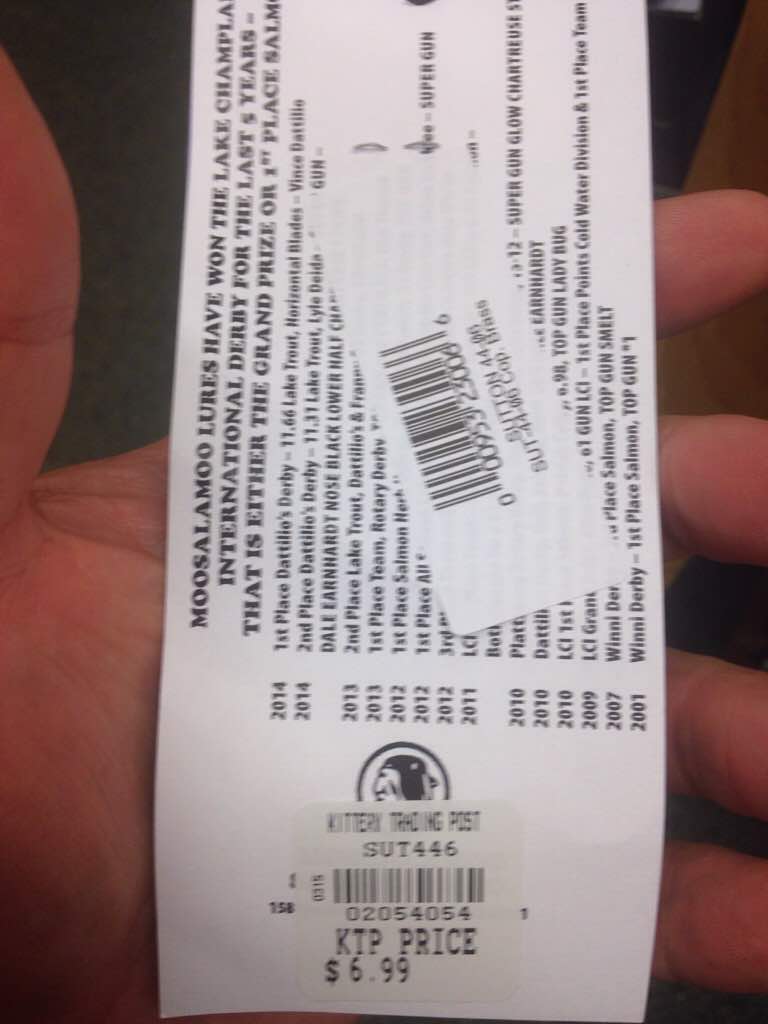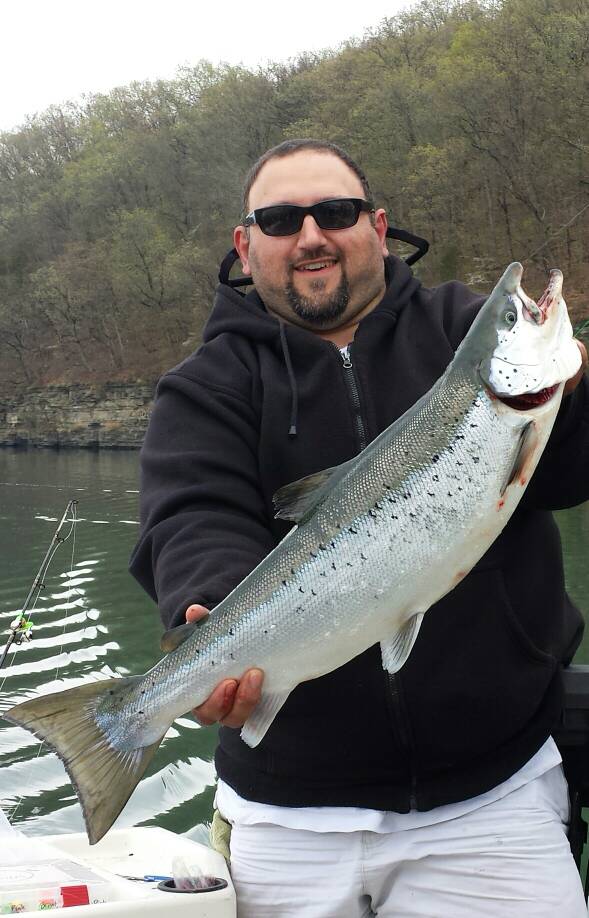-
Posts
13,863 -
Joined
-
Last visited
Everything posted by Sk8man
-
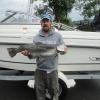
copper questions for a new guy
Sk8man replied to mcconnell14's topic in Questions About Trout & Salmon Trolling?
On rigs with 7 strand 30 lb SS wire (1,000ft) I use a minimal amount (e.g. 50 ft or so) just to protect the spool spindle of the reel from binding pressure but some guys prefer to tape the wire directly to the spool with electrical tape. The chances of being "spooled" with1,000 ft of wire is pretty remote either way and either way works. The more critical thing with stranded wire is starting it on the spool in alignment with the level wind mechanism so that the wire goes on straight rather than on an extreme angle across the spool starting out. Some folks also run out into deep water before first use and put a heavy sinker on the end and let out a large amount of wire and then reel it back in to compress the wire evenly on the spool. Always remember - to keep tension at all times (even during storage) on the wire or you will have curly q's and kinks in the wire. Always let it out slowly when deploying it and avoid "free spooling" or you will have the worst mess you've seen it is best to gradually loosen your drag and lowly deploy your dipsey. Many people tie their wire right to the sturdy solid ring ball bearing swivel snap using a "haywire" knot but I'm "old school" and still use a wire crimp which I coat fully in transparent hot glue so I can still see inside to monitor the connection. You should routinely inspect the connection for frayed or broken strands and cut back a small section and redo it if problems are evident. You can use either fluoro or mono from the wire to the dipsey and either for the fly but I prefer 50 lb mono for both because it is fairly stiff (like fluoro) yet has a minimal amount of stretch if a big king jumps on it. The wire obviously has no stretch to absorb impact. Some folks use "snubbers" to allow for some stretch but I got away from them years ago and have never gone back because I didn't feel that I was getting as many good hookups with them but others on here swear by them...again personal preference. -

copper questions for a new guy
Sk8man replied to mcconnell14's topic in Questions About Trout & Salmon Trolling?
Although a dipsey can be run from either copper or leadcore it may not be the easiest or best option usually. Seven strand stainless steel wire in 30 lb test gets down pretty good with dipseys and 50 lb braid is another option (need to use mono backing underneath it to keep it from slipping on the reel spindle). Both give pretty good control of depth. Neither of these options have much if any stretch in the main line to the dipsey and that is important with dipseys. If you intend to run dipseys off big boards or inline boards braid may be the way to go because unless you are very experienced with wire you'll probably end up kinking and have to cut it. If fishing Lake O and the Finger Lakes you'll be confronting the seasonal problem of water fleas as well and if they are bad they will attach to just about anything so frequent checks of your lines is advisable to avoid major flea "pileups". A copper rig is usually used to run single spoons or stickbaits either straight back or down the chute (in back of the prop wash ) OR run from boards by attaching to the mono or braid backing once the length of copper has been fully let out. The exact length and weight of the copper in conjunction with your boat speed will largely determine the depth at which your lure runs (slower deeper faster higher etc.). Copper wire is relatively soft so special hardened tips or eyes in the rod are not necessary. Stainless stranded wire on the other hand requires either a twilli tip or a roller tip in order to keep your rod eyes and tip from being chewed up. Also be aware that the line guides on some reels can also be cut into if they are not specifically "hardened" ones (e;g; if they are just brass with plating on them). The length of copper wire used is also a factor to consider both in terms of reel line capacity and in terms of the reel gear ratio. If you ever pull in a 600 ft copper rig you'll immediately understand why (and end up with Popeye arms as well ). A fluoro leader in desired length (personal preference issue) is attached to the copper wire using specific knots http://www.animatedknots.com/?LogoImage=LogoGrog.jpg&Website=www.animatedknots.comfor that purpose or using a small Spro #8 barrel swivel (which will go through most rod tips and eyes) and solid ring ball bearing swivel at the end where the lure is intended to go). Some folks prefer to use just a duolock snap at the end with a Spro swivel placed a few feet up the line. With a SS wire rig some folks prefer mono over fluoro because they actually want a little stretch from the wire to the dipsey or even to the flasher and then use fluoro just for the lure or fly. I prefer 50 lb mono for the flasher or Spinney to the fly on Lake O and 30 lb for the Finger Lakes. For either a copper rod or wire rod you want something with a good backbone to it but actual length is a personal preference and somewhat also depends onhow your rod holders are set up and what else you are running. I stick with relatively short 6-7 ft rods because I often go solo and it is easier netting fish. -
Tom hit the nail on the head when he said not to get too wrapped up in "exact" speed. Despite the belief of some folks down speed measured on a Fish Hawk (or any other device for that matter) is still a RELATIVE measure because you are not accounting for your lure, its action and the trajectory of it on your line behind the boat. For example if running a light flutter spoon way back it may in fact be up much higher than your downrigger weight depth and with varying current within the water column could be running at a much different actual speed than your probe. So again as Tom mentioned the important thing is to be able to REPLICATE the relationship that catches fish on your particular boat with your particular equipment given similar conditions (also dependent on species of fish....for example if a laker is caught at a certain depth and speed you may want to come up higher and troll faster if targeting rainbows)
-
maybe here? http://www.westmarine.com/
-

Hughes 5/9
Sk8man replied to Frogger's topic in New York Fishing Reports - Lake Ontario (South Shore)
Good practice for the Seneca derby fellas This is already starting out to be a strange season weather wise....these warm days and some rain may set things in gear. Good shakedown cruise.....maybe shook the Florida cobwebs out of Mikes head. -

Would like to pick your brains
Sk8man replied to JimB's topic in Questions About Trout & Salmon Trolling?
Much of the answer to your question will vary from year to year depending many seasonal factors such as the winter we had, how much available sunlight we've had, wind driven currents and how they distribute. I've always looked at the Spring conditions as being a "guesstimation" game at best. For starters though it is good to consider water stratiification factors as basics - instead of stratifying or layering vertically it is often layered horizontally in the Spring before the thermocline forms. The water warms first in the shallows to any degree vertically beneath the surface and also at the very surface where the water isn't subject to extreme currents but here the wind plays a major role in mixing things up in place or transferring pools of warmer water acrossed the surface horizontally. Where the warmer pools meet with significantly colder water thermal breaks are established and they can often act as barriers or cordons for fish sometimes broken down by species and seemingly "trapping" within or at the outside edge the barrier so it is wise to exploit this by trolling along these thermal breaks weaving in and out of them. This is also true of "scum lines" where debris is trapped by the wind and thermal conditions that are set up. These may be near shore or in bands out further so it is often fruitful to patrol around and if permitted (actual debris isn't problematic) weave through the edges of them.. This is especially effective for early season browns. Another thing to exploit with browns is their sensitivity to water temp.Often just a few degrees of warmer water (especially early in the season) such as that found around stream mouths or warm water discharges of power plants etc.and in the extreme shallows cruising for food e.g. around docks or structure especially in bays on Lake O or shorelines of the Finger Lakes. Often they are found in the early morning hours or in the evening as they seem somewhat nocturnal and avoid bright light most of the time (e.g. they go deeper as the day moves on when it is sunny) regardless of water temperature. Lakers also look to the shallows in the early Spring but rather than temperature differences it seems to me it is more related to bait searching and bait availability because they are still usually scrounging the bottom areas and especially near where there are significant drop-offs or bottom structure as well as in the shallows. They are real "opportunists" and have a real varied diet and from time to time even scrounge up dead bait. Usually the warmer temps produce this time of year but often that is where the bait is or nearby and usually if you can locate the bait pods that form in the Spring the trout and salmon are found nearby regardless of specific water temperature but fish also range great distances looking for bait especially the salmon so you may find them in the middle of nowhere out there too. It is difficult to pinpoint the exact amount of temperature change that gives rise to horizontal stratification it can be as little as a couple degrees sometimes and larger amounts other times. In my opinion looking for specific optimal temperature preferences vertically at this time of year is like peeing in the wind....not productive. Looking for bait and thermal bars and breaks can be a lot more useful of your time and exploring the surface areas "prospecting" and running close in the points or structure with toplines, and or boards and working them in and out and varying your trolling speed ranges especially near river mouths. Others on here may have quite different ideas about it but this is my take on it based on my own experiences both on Lake O and the Finger Lakes. -
They are still the most effective way to catch lakers consistently without downriggers or much in the way of additional equipment although in Lake O it sure isn't all that difficult to get them no matter what you use when they aren't out too deep. It just has to be something that can get you down near the bottom regardless of depth fished.
-

Fishing Honeoye on the weekends - A warning!
Sk8man replied to Sk8man's topic in Finger Lakes Discussion
I wish that were the case (and I was secretly getting into them) Good one! -
If you run dipseys from 7 strand wire rods you can instead of the dipsey put a three way swivel on your existing swivel snap (providing it is stout enough) and run sets of cowbells off them with either a peanut or Spin - Glow about 18-24 inches in back of them and a 24-32 oz sinker on a 2 ft drop line off the bottom of the three way. Run it jsut off bottom while maintaing it by letting out wore as you go deeper.
-
My son and I tried for the eyes again last night (unsuccessfully only caught bass) fishing from shore (luckily) on a Friday night and right from the time we started (9 PM) experiencing "party central" both on shore all over the lake and more notably on the water. I don't have a problem with responsible partying but there were numerous boats fishing with few lights lit some anchored and several "recreational" boats running full tilt in the complete darkness (with no lights at all)with the male and female occupants hooping and hollering and swearing at the top of their lungs and popping beer tops for hours and others running back and forth in and out to their cottages with more booze etc. and people shooting off fireworks. The wind was still so you could hear everything out there (conversations etc.) so it wasn't a matter of me "assuming" what was going on. I'd be the last one to get down on folks for partying but that situation is so freaking dangerous it is absurd. My son who lives right near the lake itself said it is a weekly occurance there on weekends. Just an FYI for anyone intending to fish at night for walleyes or crappies on the weekends.
-
Another fine example of the worth of this website and the fishermen willing to help someone out....in the old days before this you'd be stuck calling around all over before realizing you were screwed. A little social cooperation goes a long way these days and is good to see.
-
-
-
-

Wanted Daiwa 47lc reel
Sk8man replied to Greenhead's topic in Classifieds - Buy, Sell, Trade or Rent
I believe the model 47's were originally black but when they age they take on a grey cast to them. -
Yeah it is the reason Hop gave me the name White Porcupine many years ago (all the rods sticking up on my Whaler) They do give you some strange looks at the launch ramps when you are all alone in the boat with 16 or 18 rods sticking up and I've also had the DEC guys check me out on the water a couple times because of it
-
I keep an extra bilge pump with a length of flexible hose on it with alligator type clips attached (so I can hook it to either battery in an emergency or to help someone else out) but I've never had a drop of water in my boat thus far ever so maybe its main function is psychological at this point
-
-
-
-
-
-
While you are there and if you have time check out the Woods Hole Oceanographic Institute and take the ferry to Nantuckett
-
I'm not sure what size/brand motor you have (HP) but first of all I'd check to see which props the manufacturer of your motor recommends because if you get the wrong one it could create a problem with your motor (e.g. wrong size or pitch and possible over revving at top end).. The information may be in your operators manual if you have it. If not contact a marina that sells that particular brand of motor. If all else fails consider attaching a trolling plate to the anti cavitation plate on the motor (most bolt on). You wiould be able to get pretty much whatever trolling speed you need with that. You definitely want to have a correctly matched propeller no matter what you decide.
-
As I was first reading the post (before looking at the pic) I was thinking it was going to be a big brown because the landlocks are usually air born early sometimes even before you realize they have hit something of yours but big fish often do different things and that one sure is a beauty That pike isn't too shabby either



